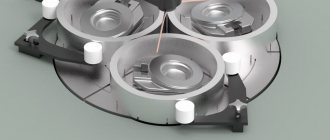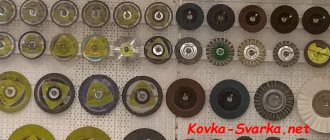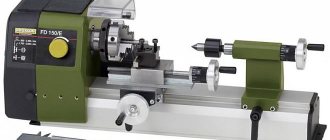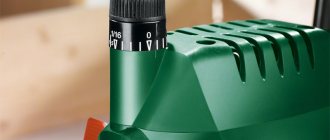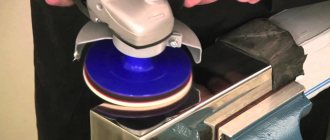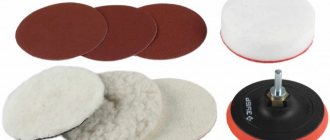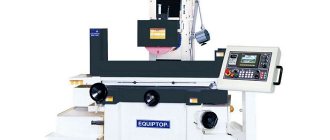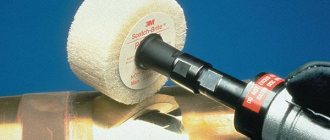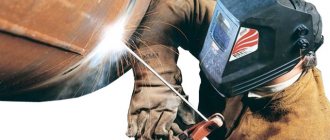The surface of metal workpieces immediately after casting or cutting is rough and has burrs, and therefore the products are not suitable for use and require finishing. To obtain the required smoothness (up to 1.25 microns), processing on a grinding and polishing machine is required, which will eliminate increased roughness.
For these purposes, equipment with combined functions (grinding and polishing) or grinding and polishing installations that perform only one of the operations is used.
The main task of such machines is to remove damaged particles from the metal surface that were formed as a result of previously carried out processing. Excessive parts of material, for example in pipelines, interfere with further operation.
The grinding and polishing machine is used to perform the following operations:
- For internal and external polishing of metal of various shapes.
- For sharpening tools and abrading surfaces.
- To create outer and inner bore diameters on shafts and bushings.
- For turning threaded products, as well as for sharpening teeth on gears.
Grinding and sharpening machines are also used for processing extremely fragile materials, including ceramics and magnets.
How to make the right choice?
To perform grinding and polishing functions, choose high-performance models offered by the VSS-Group company. Before you buy a polishing machine, decide what specific tasks you need to perform.
Equipment is distinguished:
- Sharpening and grinding - used in industry for sharpening and grinding piercing and cutting tools.
- Cylindrical grinding - for products in the shape of a cone or cylinder.
- Flat polishing - for straight, flat workpieces..
- Internal polishing - for polishing the internal surface of metal products.
The selection criteria are parameters such as the rated power of the drive motor, the maximum dimensions of the workpieces, the permissible polishing angle, the dimensions of the equipment, and the number of revolutions per minute.
In the catalog you will find high-performance grinding and polishing machines, as well as equipment of other series and modifications that will fully satisfy the requirements of the production process, and most importantly, will eliminate roughness from the surfaces of metal workpieces that do not allow the final use of the product.
The cost of grinding and polishing machines also influences the choice. The VSS-Group company sells domestically produced products and is the official representative of large European importers, and therefore we offer polishing and grinding machines at the most reasonable prices.
Also on topic...
Areas of application
A device used to process metal is called a polisher or grinder. With its help, workpieces are processed and at the same time a surface roughness level of up to 1.25 microns is achieved. The machines are used for grinding parts made of different materials.
Using the equipment you can do the following:
- polishing the metal, both inside and outside the workpiece, and they can have different shapes;
- sharpen the tool;
- peel off surfaces;
- grind products with threads on the surface, sharpen teeth on gears;
- cut grooves for mounting on shafts;
- process fragile materials, workpieces made of magnets and ceramics;
- perform operations at increased spindle speeds, which increases equipment productivity.
Design and principle of operation
Metal polishing machines have the following equipment:
- abrasive wheels and tapes;
- stabilizing devices for workpieces;
- motor and mechanism for transmitting rotation to the tool;
- wires and cables for 220 V or 380 V;
- base made of cast iron or high-quality steel;
- cooling system and self-cleaning from chips during machine operation;
- devices for measuring the level of surface roughness.
The equipment can be supplemented with devices to protect against chips getting into the eyes and respiratory tract. The use of special products extends the service life of the equipment.
The part is processed by rotating an abrasive wheel or tape with crumbs applied to it. As a result of pressing the workpiece, metal chips are removed when the surface rubs against the abrasive. A small amount of metal is removed in one pass, which is why the polishing process can take a long time. Various materials are processed, for example, stones (including precious ones), ceramics, glass, wood.
When adjusting the immersion depth of the wheel, the stiffness readings should be taken into account. The coarse grain removes a large amount of metal in one pass. Next, it is recommended to use a fine abrasive to smooth out surface roughness.
Specifications
The polishing and grinding machine has the following technical characteristics:
- the power of the drive motor in private workshops is up to 200 W; in production, readings of up to 1 kW are used;
- a set of abrasive tools with grains from coarse to fine, as well as felt circles;
- rotation speed from 15 revolutions per minute;
- The size range of circles starts from a diameter of 250 mm, with a thickness of up to 50 mm.
Powerful machine
Varieties
Polishing machines are frequently used equipment in industry. Thanks to them, workers can sharpen cutting tools. In production workshops and in everyday life, equipment of different designs is used, necessary for certain operations. The following types of polishing machines are distinguished:
- sharpening and grinding;
- calibration;
- tape;
- cylindrical grinding;
- flat polishing;
- internal polishing.
Sharpening and grinding
The design of such a machine is based on a motor with asynchronous rotation of the internal field. Used in industry. Wheels with different abrasives are attached to the rotor shaft on both sides; the finest grit is attached through a gearbox to reduce the rotation speed. Installation of additional protective screens is allowed. This mini machine can be used at home for sharpening cutting tools.
Calibration
Using such installations, wooden surfaces are processed, protrusions and transitions are smoothed. Chips are removed from the workpiece using a tape with abrasive chips applied to it. The machine is used for finishing.
Tape
Settings are used for more precise operations at the end of processing. The belt rotates using an engine at low speeds, tension is produced through a gearbox. Used in processing wooden products.
Cylindrical grinding
In terms of design, a cylindrical grinding machine is similar to a lathe; it is used in industry for polishing cone- and cylinder-shaped parts. Has a device for fastening and changing the rotation of the workpiece.
Flat polishing
Used to remove roughness from workpieces that have a straight, flat shape. To prevent distortion, the design uses a magnetic fastening.
Internal polishing
Used for polishing the internal surfaces of parts made of metal. The workpiece is fixed motionless, rotation is imparted only to the tool. Several spindles can be used in the design.
How to polish alloy car wheels?
Do-it-yourself mirror polishing of cast wheels allows you to return them to their former shine. What is the overall procedure? Typically this involves disassembling, painting and polishing the rim and shelf. The same goes for polishing the rim and shelf. The process requires a considerable amount of time and effort, as well as great desire. But polishing aluminum wheels will add chic and shine to your car.
The scope of work is quite decent, not for one week.
First you should start disassembling the alloy wheels, then scrape off and dissolve the old paint, then pick up a new one and paint it. In general, be patient. To carry out the work you need to purchase the following tool:
- sheets of sandpaper of different grain sizes (from fine to coarse);
- low speed drill;
- a special drill attachment with Velcro;
- felt circle (with Velcro);
- wool circle (with Velcro);
- Goya paste, 3M polishing paste;
- metal polish;
- You may need a grinder with a grinding wheel.
Selection principle
When choosing grinding and polishing machines, you need to consider the following technical parameters:
- rated power of drive motors;
- maximum dimensions of the processed workpiece;
- permissible surface polishing angles;
- individual equipment sizes;
- number of tool revolutions per minute.
Advantages and disadvantages
The advantages include:
- simplicity of design;
- high productivity;
- low labor costs;
- elimination of roughness and scoring on the surface of workpieces, which can provoke corrosion;
- convenient fastening of the part, as well as the use of additional means to protect against chips getting into the eyes and respiratory tract.
Negative properties include the appearance of surface stress in the metal during processing at high speeds.
Compact machine
Manufacturers and cost
Metal polishing and grinding machines are produced both by foreign companies and domestic factories. The price of products can start from 5 thousand rubles and depends on the functional features, dimensions, and technical characteristics.
Basic operational capabilities of polishing machines
There are not too many criteria for choosing such devices, but they are all important - the class of equipment, its power, the weight of the tool, the maximum diameter of the disk, the presence of a speed control system. All polishing machines are divided into two large groups by class - professional and household. If you are going to use this unit from time to time, then you do not need a professional tool, since it will cost much more than a household one.
Power affects the maximum load applied to the machine. Accordingly, a more powerful device can finish the job in less time. This figure usually varies from 400 to 1500 W. The higher the power, the greater the mass of the tool. It is advisable to purchase a design that weighs less - your hands will get less tired when working, and you will not need to take breaks to rest.
The diameter of the polishing disc also affects the overall performance - this parameter ranges from 120 to 240 mm, the most popular models today are those with diameters of 125, 150 and 180 mm. This factor directly affects the power - the higher it is, the greater the power. It is desirable that the machine has an electronic system for adjusting and maintaining speed. This feature will allow the device to maintain a certain number of rotations per minute, regardless of the load on it; accordingly, the work takes less time and is of better quality.
When choosing models for inclusion in our review, we, first of all, paid attention to all the factors discussed above, and also took into account the price-quality ratio of products, and largely relied on user reviews. For each product, we tried to collect the maximum amount of information so that you can choose the optimal tool for yourself.
Exploitation
When working on a polishing machine, it is recommended to follow the safety requirements:
- protect your eyes with glasses; when rotating a workpiece or a circle, small parts may break off at high speed;
- tuck hair under a hat;
- It is prohibited to stand directly in front of the equipment;
- Do not use gloves or long protective clothing;
- At the end of the work, the polishing machine is cleared of chips, and surfaces susceptible to corrosion are lubricated.
Proper operation and maintenance allows the consumer to achieve a surface with the required level of roughness.
Technologies and means for polishing metal to a shine
Metal polishing: features of the preparatory and main processes. Metal polishing classes according to GOST. Various methods, means and machines for polishing and grinding metal to a mirror shine.
Metal polishing is the final stage in the manufacture of metal and alloy products, which consists of removing the thinnest possible layer of material from the surface of the part. There are a large number of ways in which you can polish a product to a shine, both at home and in industrial production. They are described in detail in this article.
Restoration work
The restoration treatment procedure consists of several stages:
- washing the surface with special liquids to remove old polish and dirt;
- grinding the body using diamond paste (in the future it is necessary to use those pastes that are compatible with it) and abrasive polishing. It is important not to damage the paint layer;
- Before the last layer, the surface is washed again, degreased, and any remaining paste, polish, or abrasive is removed;
- The last stage is the application of a non-abrasive protective agent.
Description and properties of the polishing process
GOST 9.301-86 regulates the requirements for the quality of processing of metal products as a result of polishing work. There are no special instructions regarding the gloss of surfaces after grinding, however, after polishing various defects, grooves, scratches, burrs, corrosion, etc. should be excluded.
In a word, polishing activities are designed to give the product an attractive appearance and consumer qualities.
In production there is such a thing as “polishing class”. The level of surface roughness of a particular part is determined using special equipment (microscopes and profilographs) down to 1 micrometer (μm, 1 mm = 1000 μm). If metal grinding is carried out at home, then the depth of the unevenness is determined by eye.
There are 14 roughness classes, which are indicated in special drawings in accordance with GOST 2789-59.
Polishing classes and requirements for them are presented in the table below.
| Surface description | Roughness size (up to microns) | Polishing class | Mechanical processing method |
| Traces of processing are very noticeable | 320 | 1 | Planing, sharpening and milling |
| 160 | 2 | ||
| 80 | 3 | ||
| Traces of processing are very faintly visible | 40 | 4 | Soft abrasive, semi-finishing |
| 20 | 5 | ||
| 10 | 6 | ||
| Traces of processing are not visible at all | 6,3 | 7 | Fine flow, grinding |
| 3,2 | 8 | ||
| 1,3 | 9 | ||
| The surface of the metal product is perfectly smooth and has a characteristic mirror shine | 0,8 | 10 | Final polishing, soft polishing |
| 0,4 | 11 | ||
| 0,2 | 12 | ||
| 0,1 | 13 | ||
| 0,05 | 14 |
Do-it-yourself machine for polishing discs - Metalworker's Guide
Very often, car wheels are one of the first elements of car tuning, as their owners want to emphasize their status and individuality. But no matter how expensive the discs are, sooner or later they become faded and dull. Polishing the discs can help with this problem.
Why is wheel polishing necessary?
Polishing car wheels is designed not only to provide an external shine, but also to protect them from corrosion, which can occur in the smallest scratches and chips received during operation.
Polishing car wheels is designed not only to provide an external shine, but also to protect them from corrosion.
Necessary tools and scope of work
If you decide not to go to the salon, but to do the work yourself, please note that this process is long and labor-intensive, it must be carried out in a well-ventilated area. It consists of several stages:
- cleaning;
- grinding;
- polishing
During work, be sure to use personal protective equipment (gloves, respirators) to avoid chemical burns to the skin and respiratory tract and the entry of small particles into them.
To clean the disk from dirt and protect it, you will need:
- water and detergents;
- mini sink (Kärcher type), if available;
- remover for paint and varnish of the appropriate type;
- putty knife;
- abrasive of different grain sizes.
Mini washer
The grinding process requires a drill or sander with abrasive attachments. If you have a grinding machine, you can use it.
Experienced car enthusiasts can try performing the sanding and polishing steps directly on the car.
To do this, you need to jack up the body on one side and place the wheel and disc on the hub, then start the engine and carry out processing at low speeds.
The better you complete the previous steps, the more you will be pleased with the result when polishing is complete.
For polishing you will need:
- tools from the previous stage with felt, felt, denim attachments;
- polish;
- fine-grained abrasive;
- polishing paste;
- grinding/polishing machine (you can assemble it yourself using diagrams from the Internet).
How to choose a wheel for polishing a car
Polishing paste
Do-it-yourself technology
The process of polishing discs with your own hands should be performed in the following sequence:
- remove the disks;
- Wash them using your hands with detergent or using a mini-wash;
- treat the surface with a remover and remove the old coating of the discs with a spatula (carefully, without leaving scratches; if you want to remove not only the varnish, but also the primer, apply the remover a second time, wait until the coating swells, and remove it with a spatula);
- wait until the chemical composition dries and wipe the disc with a soft cloth, the surface should be smooth and not porous (if not all of the soil has been removed);
- Sand the areas where the coating remains;
- grind the disc from the center using a power tool or on a machine at low speeds in several approaches so as not to overheat and damage the disc;
- use abrasive from coarse to fine (P240–1200), until traces of use disappear (small scratches and chips);
Use abrasive from coarse to fine
- Before each change of abrasive brand, blow abrasive dust from the surface of the disc and wipe with a rag;
- in hard-to-reach places (if the disk is not collapsible and of complex design), grind by hand or with narrow conical drill bits;
- polishing is performed in a similar way to grinding, using polishing paste of different grain sizes and soft attachments;
- at the end of the work, the discs must be washed with detergent and wiped dry;
- If desired, you can protect the surface of the disc with a layer of automotive varnish (apply from an aerosol can or with a thin brush).
There are three types of disks:
- steel;
- cast;
- forged.
Forged wheels
The lightest and most fragile of them are cast, so working with them deserves special attention:
- finish grinding the cast wheels with 3000 grit abrasive;
- perform work with power tools in short cycles and without force;
- grinding/polishing with one brand of abrasive should not exceed 5 minutes;
- To polish to a mirror finish, use soft polishing pastes;
- Apply the paste to the polishing wheel and “rub” it into the surface of the disc in a circular motion, first by hand until the color changes, then at low speed;
- wipe the surface with a microfiber cloth;
- wash and dry the disc;
- do not forget to protect the surface after polishing with polish (Teflon or wax);
- the entire process should take between 40 and 90 minutes.
You can omit the disc grinding process if there is no damage, and you just need to update the mirror shine.
Mirror polishing of discs
Advice from professionals
To simplify this difficult process, you can use life hacks from professionals:
- Before polishing, to speed up the process, heat the GOI paste or dilute it with kerosene;
- deep scratches can be sanded with a file;
- you can use toothpaste for polishing, and a toothbrush as a tool for hard-to-reach places;
- You need to work with aerosol varnish in a circular motion;
- The grinding/polishing paste should not dry out on the surface; periodically moisten it with water from a spray bottle;
- Using protective detergents to wash discs will prolong the polishing effect;
- be careful about the composition of the polish; ammonia or acid in the composition contributes to the destruction of the coating and, as a result, corrosion;
- polishing wheels for power tools are distinguished by color: polishing wheels for power tools are distinguished by color: white - for more grainy, black - for fine-grained, orange - universal;
- During operation, periodically clean the polishing wheels with a brush;
- Aluminum wheels do not tolerate polishing pastes; during operation, the surface heats up and reacts, which results in oxide and stains. If you want to polish with paste, do it by hand.
We remind you that you can entrust each of the described stages to professionals at the service station, who have high-precision equipment for diamond grinding and tumbling of discs to a mirror shine.
Mirror polishing of car wheels
Car rims are like shoes for a car. It’s not for nothing that at first glance a person is judged by his clothes, or more precisely, by his shoes. It's the same with a car.
Even if the car is worth several million, if the car's rims are in poor condition, dirty and scratched, this will worsen the appearance of the car.
Polishing car rims will help restore the original newness, which any car enthusiast can handle.
A shiny disc really looks very beautiful, don’t be lazy to polish yours
Types and features of wheel rims: stamped and not only
When you decide to polish yourself, study the types of car wheels, because for each type there are rules and costs.
Stamped wheels are a common type of “shoes” for cars. They gained popularity due to their low price, 1000-1500 rubles.
More often, stamped ones are “native” to the car, and drivers are in no hurry to change for others.
And there’s no point in that, because these ones won’t split when they fall into a hole, but will crumple, as a result of which they can be repaired without any problems
The disadvantage of this type is its weight, unlike forged and cast analogues. Also, the lack of variety in appearance is a disadvantage. But this problem can be easily overcome with the help of wheel covers, which will change the appearance of the car.
Cast
Cast ones differ from stamped ones in their lightness, because while the former are steel, the cast ones are aluminum. The second advantage of this material is thermal conductivity, which helps remove heat from the brake mechanisms. The technology for manufacturing alloy wheels allows you to create any shape, which is why car owners love them.
But there are also disadvantages. If the discs fall into a hole, they will crack, and it is impossible to restore them, only replace them by purchasing one for 4000-5000 rubles. Despite this, the cast material has many supporters among drivers.
Forged
Automotive forged wheels combine the advantages of the first two types. Despite their lightness, forged ones are durable and do not split if they fall into a hole. But there is also a minus here. Due to its strength, the load is transferred to the suspension, so getting into holes with a forged version is fraught with serious damage.
Forging is a very durable invention and is very popular
https://www.youtube.com/watch?v=t4Ifs7hw_E4
They do not differ in variety of appearance, but the price is maintained at the level of 3000-4000 rubles.
Preparatory stages
Industrial enterprises that engage in various types of metal processing check the condition of surfaces before grinding begins. Before using various chemical reagents and polishing machines, the part must be prepared for further stages of polishing; for this, the product is affected by one of the mechanical methods:
- processing the part with compressed air together with special coarse abrasive elements that remove large build-ups of corrosion and rust from the surface;
- cleaning the surface of the product with brushes with stiff bristles to remove signs of oxidation and sludge (dust formed as a result of cleaning with a coarse abrasive);
- degreasing surfaces from traces of previous polishing agents by treating with warm organic solvents;
- the use of alkaline solutions to remove residual mineral substances containing oil;
- electrochemical degreasing (immersion of a metal product in an electrolyte).
All these methods are most often used in industrial production conditions. At home, to prepare a metal product for polishing, it is enough to treat the surface with sandpaper of varying hardness.
Materials
Polishing is carried out using circles, as well as applicators for applying wax and polishes. For manual work, they can be replaced with foam rubber. To polish the layer manually, use flannel, flannel, cotton fabric, or felt.
Coarse wheels (felt) are used for coarse abrasive pastes; if they are applied to a foam wheel, it will tear, so you need to read the instructions for the polishes.
The hardness of circles can be determined by their color:
- white – the hardest, suitable for abrasive paste;
- orange – neutral, for all types of pastes;
- black - for the softest finishing product.
Deep grinding of the body is carried out with special sandpaper for polishing. This is not an ordinary “sandpaper”, it has a very fine abrasiveness from 1500 to 1300. Abralon with an abrasiveness of 4000 is also used. These materials are suitable for professional work - they are difficult to use without experience.
Metal polishing methods
The following types of polishing are used in metal processing plants:
- mechanical;
- chemical;
- electrochemical;
- using plasma;
- laser;
- ultrasonic
Mechanical method
A grinding machine is an indispensable tool for high-quality polishing of metal until its original shine appears. The polishing machine has a so-called abrasive wheel, the coating of which will depend on the nature of the work and the material.
The process of metal processing using a grinding machine will proceed as follows:
- The polishing wheels and the area of metal that needs to be processed are moistened with water. To process metal, the disk must rotate at a speed of 1400 rpm. It must be taken into account that at such a rotation speed the spray will scatter 1–1.5 meters, so care must be taken to adequately protect the face and clothing.
- The surface being processed will begin to heat up as a result of friction, and the water will evaporate. As a result of this interaction, unevenness and roughness will be removed, forming blockages of metal particles and water on the base of the abrasive wheel. Every few minutes you need to turn off the machine and rinse the disc under running water. Metal particles should be removed not only from the tool, but also from the surface of the product.
- To achieve a mirror shine, it is recommended to use felt material. This attachment is placed on the grinding disc so that the edges protrude 1–1.5 cm beyond the border of the circle. The felt and the surface of the metal part must be moistened with water, after which the final polishing of the metal occurs.
If you don't have a special machine, you can use a polishing agent such as sandpaper. First you need to sand the surface with a coarse abrasive, and then a softer one. After switching from one grain size to another, you can begin the finishing stage of processing.
At the final stage, polish is used. For metal products, as well as for stone surfaces, diamond paste is excellent, which can restore surfaces to ideal smoothness and mirror shine. The surface of the metal product is carefully treated with a cloth onto which the polishing paste is applied.
Chemical polishing of metal
Chemical polishing is the most effective solution for metal products and alloys that have a decorative function.
The essence of the chemical method of cleaning metal is that all the work to restore the surface of the product is performed by special solutions of chemical reagents and acids.
The solution must be heated to a certain temperature, which depends on the components of the metal alloy, after which the metal product is immersed in the solution for several minutes. A reaction occurs between the metal and the chemical solution, as a result of which the defective layer of the product is destroyed.
In order to immerse the part in the solution, special holders are used. There is no need to use manual labor, and metal processing occurs evenly over the entire surface.
However, this method has a drawback: after the procedure, the surface of the product is more matte than shiny. In addition, this method requires compliance with a number of safety rules.
Electrochemical metal polishing
The current accelerates the process of destruction of the oxide layer even in barely noticeable depressions on the metal surface.
As a result, the product acquires perfect smoothness. This method is perfect for those who are looking for an answer to the question of how to polish metal to a mirror shine.
The disadvantage of this method is the high energy consumption and the need to regularly replace the chemical solution.
Plasma polishing
Polishing metal using plasma is similar to the electrochemical cleaning method: the product is also immersed in a chemical solution, followed by an electrical discharge through it.
However, the electrolyte-plasma method does not involve the use of a mixture of chemical reagents and acids, but a harmless solution obtained from ammonium salts.
The result of electroplasma polishing will be not only a mirror shine and perfect smoothness, but also additional protection against corrosion.
Laser metal polishing
A laser device acts on the surface of metal products by delivering pulses of light. The energy, in contact with the metal, is converted into plasma, its particles disintegrate, which leads to the appearance of a shock wave.
The light pulse is not long enough to damage the product, but it does break down damaged metal particles.
Due to this feature of the laser beam, if the product requires deep cleaning, the same area of the metal surface will have to be affected several times.
The laser installation, made of steel, has such a feature as self-limitation. The device itself reduces the intensity of the impact and the power of the beam as soon as the laser reaches a layer of metal that does not need polishing.
Ultrasonic metal polishing
Ultrasonic polishing of metal is one of the types of processing of various surfaces by crushing, that is, the destruction of the defective surface layer is carried out after applying a load to the material.
Oscillations of the ultrasonic wave form chips and cracks, as a result of which the top layer of metal comes off by itself, like an eggshell.
This method helps out if the material is not a conductor of electric current and cannot act as an anode during electrochemical cleaning. It is also great for polishing thin and fragile items, including gemstones and metals.
Ultrasonic metal processing technology is as follows:
- A composition of abrasive elements is placed in a special working sector of the device.
- The device is located in close proximity to the surface being treated.
- The vibrating device causes the abrasive elements to vibrate, affecting the top layer of the product.
- The defective layer cracks and collapses under the influence of vibrations.
Silicon or boron particles on a carbide basis can act as abrasive elements, and the vibrating factor can be the supply of fresh water.
If you have experience in polishing metal using industrial and improvised methods, share it in the comments.
The best polishing machines
PATRIOT AG 180
These products were developed by an American company and manufactured in China. One glance at this instrument will be enough to see the high quality of workmanship and assembly. It is made from high-quality materials, thanks to which it was possible to achieve a fairly long service life of the model. All elements fit together as tightly as possible, the grinding machine is equipped with a soft start system, and no extraneous noise occurs during operation. Regardless of the force applied to the tool by the operator, the tool spindle will rotate at the same speed. Many users note that this equipment can also be used by professionals.
It is possible to manually adjust the rotation speed; the machine can be used not only for polishing, but also for grinding. The design is equipped with an ergonomic handle made in the shape of the letter D. Thanks to it, it is possible to provide a very comfortable and reliable grip, so your hands will practically not get tired during work. In order for the unit to serve for the longest possible time, the stator and rotor are armored; milled gears with meshing in the form of beveled teeth are installed in it. Equipment can be changed literally within a few seconds - this was achieved by installing a tool-free spindle locking system. The network cable here is rubberized; it retains its softness at both high and low temperatures. You can bend it as much as you like and in any way you like - this will not affect its performance.
Advantages:
- Moderately noisy;
- A huge number of innovative solutions;
- Many users even classify it as a professional tool;
- It copes well not only with a layer of paint, but also with many other materials - wood, plastic, and so on.
More: Xiaomi Redmi Note 11 and Redmi Note 11S – smartphone review
Flaws:
- It will be quite expensive;
- The rotation speed adjustment does not always work correctly.
PATRIOT AG 180
SPEC BMP-1200
This is one of the most powerful machines in our entire review - it has a 1250 W motor, due to which the maximum speed here can reach 4200 rpm. The device is perfect for working in the most difficult to reach places. The equipment almost instantly copes with minor scratches on the car body; the device can also remove rust from surfaces, work with wood and other materials, giving them an attractive shine. The power button is located in the area of the main handle and can be easily reached. The handle itself is covered with a rubberized compound that prevents your hands from slipping. The set also includes an additional handle, which will be useful if you need to put extra effort into the tool.
The tool itself does not weigh very much, so you can easily work with it for more than one hour without a break. The speed is adjustable from 800 to 4200 per minute, the adjustment is stepwise. The engine has a brake function, so it is almost impossible to get injured when working with such a polishing machine. The consumables used here are wheels or sanding felt discs; their diameter should be 180 mm. You can also install the appropriate fur attachment here, which is used for the finishing stage of working with the surface.
Advantages:
- Quite a long period of operation;
- Very convenient to use and manage;
- There is an engine brake that protects the user from possible injury;
- High level of quality of work performed.
Flaws:
- There is no soft start system for the engine.
SPEC BMP-1200
BISON ZPM-240
Additional 30% discount on Erborian skincare products until March 31 using promo code OZONHBP235 for products from this page! The promotion may end early.
With the help of such a polishing machine, it is possible to obtain a perfectly smooth surface when performing finishing work on materials such as wood, metal or even many polymers. The diameter of the working circle here is quite large, so the pressure on the treated area will not be too high. The device is equipped with an eccentric mechanism, the action of which is aimed at simulating manual polishing of the surface. Thanks to such possibilities, it is possible to obtain a perfectly smooth workpiece or already a product, and the work will not take too much time. This polishing machine can work not only on car bodies, it can also be used to clean up home parquet, furniture, and so on. Due to the presence of an additional handle, the accuracy of the work performed is significantly increased.
The maximum speed is 3200 per minute with a power consumption of only 140 W. The handles are all made with the addition of rubber, and are completely non-slippery due to specially applied corrugation. The start button is fixed, so you don't have to hold it all the time. The consumption of polish is economical. The fact is that the top layer of the plate is coated with special water-repellent compounds. This technological solution does not allow part of the polish to be absorbed, so all the material is used strictly for its intended purpose. The engine is well protected from overheating thanks to an innovative forced fresh air circulation system. Despite the fact that there are no additional features, this grinder will cope well with all the tasks facing it.
Advantages:
- The optimum ratio of price and quality;
- A forced cooling system is provided;
- Long service life;
- High quality manufacturing and assembly.
Flaws:
- There is no motor brake when the power is turned off.
BISON ZPM-240
Huberth RP207183
This is one of the smallest polishing machines in our entire review. Due to its small size, this device can penetrate even the most inaccessible places and perform all the necessary operations there. Despite its small size, the weight of the equipment is quite decent - over 2.5 kg. This is due to the fact that a fairly powerful motor is installed here - 1100 W, which also has an electronic speed control system. This feature allows you to polish the surface as carefully and accurately as possible, preventing the occurrence of various types of defects. There is another interesting system - the machine maintains a constant number of revolutions under load at the same level. The engine is equipped with a soft start system.
The polishing wheels are secured with special Velcro, so they can be changed within a few seconds. The spindle rotation speeds are adjusted in steps and have six levels. The eccentric size is 21 mm, so the device is suitable for both small jobs and polishing large areas. The electrical insulation is reinforced, there is a built-in fan of the forced cooling system. The sock has a rubberized coating, it is very comfortable to hold on to when adjusting the degree of pressure on the device. The handle is covered with special materials that prevent vibration from being transmitted to the user's hand.
Advantages:
- Reliability and durability of equipment;
- Reasonable cost;
- Small overall dimensions;
- Quite stylish appearance.
Flaws:
- Not very easy to find in stores.
Huberth RP207183
Status PA180M
It is also a very powerful design - the engine power here is 1300 W, the number of revolutions can be adjusted, and this figure ranges from 600 to 2500 per minute. It is worth noting that the device is very heavy: its weight is over 3.5 kg, so coupled with vibration, it will have a rather strong effect on your hands, which will quickly get tired. The power cable is enclosed in a neoprene sheath that maintains its elasticity at all ambient temperatures. Accordingly, you can use the unit almost at any time. The handle is very comfortable, it has a closed contour. There is a switch equipped with a protection system against unintentional starting.
More: Top 10 column fans
The gearbox is housed in an aluminum case, there is a button that locks the spindle in one position, so changing attachments will be very convenient. Like most of the products included in our review today, this machine has stabilization of the selected number of revolutions. The device is simply excellent at maintaining low speeds even under heavy load. The design is original, all elements in it are aimed at ensuring that it can work for a long time without interruption. The body and all internal parts practically do not heat up. The kit comes with everything you need to get started, even including a few pieces of sandpaper.
Advantages:
- Excellent build quality;
- Quite a reliable unit;
- Accuracy of adjustment of rotation of moving elements;
- Quite reasonable cost;
- Extended kit.
Flaws:
- Decent weight of the device.
Status PA180M
Makita SA7000C
Many users consider this equipment to be professional, and their point of view is not without common sense. First of all, you should pay attention to the body of the product, which is made of rubberized plastic. This is very convenient, since regardless of your grip, the machine will not slip out of your hands. Separately, it should be said about the build quality - no backlash or creaks were noticed. A soft start is provided, the engine power is at a very high level: it is 1600 W. Even with a fairly strong pressure on the tool, there is no loss of speed. If a disk of small diameter (around 125-150 mm) is installed, the device does not start to heat up. At the end of the product there is a button responsible for stepwise speed control. Here you can also find a nameplate with information on the key characteristics of the product.
The device has a decent weight and does not vibrate too much in your hands, but is still very sensitive. The handle here is approximately the same as that of a classic grinder. In general, the tool itself is unpretentious in terms of operation. If necessary, you can disassemble the housing and replace the motor brushes. The device can easily cope even with significant volumes of work, and even with intensive use it does not heat up, so this will not in any way affect the duration of its operation.
Advantages:
- Very convenient, reliable and well-thought-out model;
- Can easily cope with a significant amount of work;
- The number of revolutions can be easily adjusted;
- Clear instructions in Russian;
- Easy to maintain;
- Characterized by a long period of operation.
Flaws:
- Significant mass of equipment;
- The shape of the handle is not very convenient for such a tool.
Makita SA7000C
RYOBI R18B-0
The main distinguishing feature of this tool is its complete independence from the power supply, since the equipment is equipped with a reliable lithium-ion battery. Unfortunately, it is not included in the kit, so you will have to purchase the battery separately. This product, developed by a Japanese company, is very convenient to use. First of all, there is no need to use extension cords, carriers and other structures that can greatly interfere with work. This feature allows you to polish the car body almost anywhere. If we talk about the power of the battery itself, then it will be quite enough for the tool to start rotating at a speed of up to 2.5 thousand revolutions per minute.
At the same time, the weight of the battery is not too large, so even with the battery installed, the tool will remain comfortable for use. In this case, it will also be easy to operate, just like an ordinary corded polishing machine. This device is orbital - the eccentric rotates along a reciprocating trajectory. Thanks to this, it is possible to easily cope with even fine processing of the paint layer, and this applies to both convex and concave areas. It is not possible to change the eccentric stroke manually, so it is unlikely that it will be possible to adjust the operation of the polishing machine to certain conditions. The product comes with two discs - one fabric and one wool. With their help, you can finish the surface at both high and low speeds.
Advantages:
- Real Japanese manufacturing quality of the device;
- Availability of a battery with a long service life and a long battery life;
- Orbital rotation;
- Long period of operation.
Flaws:
- It will not be possible to configure the device (change the eccentric stroke) to suit specific conditions.
RYOBI R18B-0
3. Interskol UPM-180/1300EM
In honorable third place in our review are products from another well-known Russian manufacturer. The company itself has been on the market for many years and specializes in the manufacture and sale of household and professional construction and finishing tools. The motor power of the polishing machine is almost 1200 W. The device is equipped with an angled handle, which is much more convenient during use compared to a removable straight type. The device is equipped with a soft start system, the speed is maintained under load. The product smoothly gains the required speed after switching on, and there are no involuntary jerks in the user’s hands. The machine belongs to the class of semi-professional instruments - it is unlikely that it will be able to work for 8-9 hours without a break, but it can easily withstand about 4-5 hours without rest.
More: Top 9 most popular graphics tablets
The device is easy to use, access to the main working elements is easy, so the user, if necessary, can not only replace the motor brushes, but also the stop button. Sanding consumables are attached with Velcro, so replacing them takes a minimum amount of time. The maximum diameter of the consumable is 180 mm. The device weighs quite a lot, but this moment is minimized due to slight vibration even if the machine operates at maximum speed.
Advantages:
- Good value for money equipment;
- If necessary, you can repair it yourself;
- System of soft start and speed control;
- Comfortable body and ergonomic handle shape;
- Low vibration during operation.
Flaws:
- Decent weight of the product.
Interskol UPM-180/1300EM
AEG PE 150
This design already applies to professional products. Not only is it able to work without interruption for quite a long time, but it can be used to process a variety of materials - from wood and metal to plastic and even stone. The machine also comes with a special handle that can be installed on the left or right side of the tool, making it easier to use. The design has a special gearbox with high torque. Thanks to this element, you can quickly process any materials by optimally adjusting the speed for this. The gearbox housing reduces quantitative and qualitative vibration, so if necessary, you can hold the machine even with one hand, without fear that it will jump out of your hands and cause injury.
Like many of the devices included in this review, it provides electrical adjustment of the number of revolutions, which helps to select the optimal mode of operation of the device for each material. The engine power is very high - 1200 W, the maximum diameter of installed consumables is 150 mm - quite enough for normal operation for a long time. The speed is adjusted smoothly in the range from 900 to 2500 rpm. The 4 m long power cable allows you to connect to the mains without using an extension cord. A unique forced ventilation system was developed for such a device. There is also a button that locks the spindle, allowing you to change the attachment even faster. If the motor brushes are very worn, the motor automatically turns off without burning out.
Advantages:
- Repaired quickly and on your own;
- High-quality processing of any surface;
- Long service life.
Flaws:
- The price is quite high (although for a professional instrument this is quite normal).
AEG PE 150
DeWALT DWP849X
Well, the recognized leader in the rating is the product developed by the world-famous German company. This device compares favorably with its closest pursuers in a number of ways. It is quite natural that the design is equipped with a soft start system and reliable engine protection from overheating and overloads - this has a positive effect on the longevity of the equipment. All components are of very high quality, and the assembly is also excellent: for these reasons, the manufacturer provides a three-year warranty on its products. It is not at all surprising that this machine has a rotation speed control and a system that stabilizes the number of revolutions. The maximum diameter of consumables is 230 mm, they are attached with Velcro; if necessary, you can install a surface in smaller sizes.
The gearbox housing is rubberized. This not only increases ease of use and prevents scratches on the surface of the structure, but also protects the device from overheating. The spindle rotation speed is smoothly adjustable, and this moment is constantly under the user’s control. The number of revolutions is changed by rotating the disk-type regulator. The air absorber is covered with special replaceable mesh screens that prevent hair and dust from entering the engine - this helps to significantly extend its service life. The rear handle is rubberized over the entire surface, which makes this tool easier to use.
Advantages:
- A fairly large rotation speed regulator - it is convenient to change its position even with thick work gloves;
- The kit includes two handles for greater ease of use;
- Reliable protection against accidental startup.
Flaws:
- High price.
DeWALT DWP849X
Purpose
The scope of use of such high-tech machines is quite wide - they are used by both small businesses and large enterprises.
Polishing machines are quite a useful thing in the hands of a master and they are intended for final polishing of the surface of products up to roughness class 11-12. When working on a polishing and grinding machine, a very thin top layer is removed from the surface of the workpiece, thus finishing the material. At the heart of such an industrial machine is an abrasive wheel, which does all the polishing work on the workpiece.
Scheppach TiGer 2000S water cooled
A metal polishing machine is used to process surfaces made of stainless steel, brass, aluminum, etc. They can also be used to polish pipes, sheets of metal, various flat surfaces and extruded profiles, as well as finished parts.
Wood grinding and polishing machines are used in woodworking, furniture industry, and for the manufacture of decorative parts.
For stone processing, cantilever lever machines are used.
Such equipment can easily handle the processing of chairs and tables, polished mirror sheets, chests of drawers, and door handles. There are models that polish stone and a variety of ceramics.
Classification
A manual polishing machine is quite often used in everyday life. If for some reason it is not possible to buy one, then you can make a polishing machine with your own hands using a regular drill. To do this, you just need to clamp the felt disc into the chuck. But such a homemade metal polishing machine is not suitable for long-term operation.
There are also polishing angle grinders, which, unlike the well-known “grinder”, have adjustable speed. On such devices, the speed is significantly lower than on a conventional angle grinder. Thanks to this fact, the paintwork will not melt or deform. By replacing the polishing disc with a flap abrasive wheel, a manual sharpening and polishing machine can be used to process various products and workpieces. Using such a device, you can grind and polish the body, headlights, glass of a car, motorcycle, etc. at home.
Tabletop, but already stationary polishing and grinding machines, which some place in their garage, in a small private workshop should include an emery machine installed on a workbench or a special podium. In general, a tabletop polishing machine differs from a regular emery machine in that a different tool is installed on it.
For example, the JSSG-10 tabletop polishing machine is perfect for working at home. Thanks to its fairly rich functionality and low price, it compares favorably with its competitors. The Jet JSSG-10 v machine can be used to sharpen, straighten and fine-tune cutting tools.
You can also select polishing machines for wood and metal. But this distinction is very conditional, since the equipment itself is used the same, only the nozzle changes.
A belt polishing machine is typically used for processing flat surfaces (for example, bars, boards). For different types of wood and metal, different abrasive belts are used.
In the machine tool industry, there are polishing machines with laps (finishing machines), centrifugal and liquid ones.
Jewelry polishing machine
As for finishing machines, they are used for finishing fine grinding of the surfaces of parts and eliminating roughness left on them by previous tools.
The remaining 2 types of equipment are usually used when processing workpieces of complex shapes.
Centrifugal machines have a certain container that is filled with a special solution or abrasive powder. When the container rotates, this mixture also begins to move and polishes the workpiece.
In liquid polishing machines, the workpiece is placed in a chamber, and polishing occurs with a jet of special liquid, which is saturated with abrasive. The pressure of such liquid from the nozzle is up to 50 m/sec. During polishing, the nozzle itself moves along the workpiece.
Polishing value
Eliminating chips, microcracks, small scratches, and preventing these damages are tasks that body polishing can handle. Some work can be done with your own hands, while others are better left to car services.
Most often, work is carried out in the off-season: before the winter period and in the spring. Protective treatment can prevent the appearance of chips and microcracks from stone impacts, and minimize paint clouding. Restorative sanding is used when the listed defects have already appeared on the paintwork.
Workpiece processing technique
The method of processing workpieces with polishing equipment is based on the circular rotation of a felt (abrasive) disk and the reciprocating motion of the work table with the product installed on it. The processing disk, rotating at a certain pace, cuts off the top layer of the surface being processed in one pass, and the work table constantly moving back and forth ensures uniform processing of the surface.
The thickness of the layer removed from the workpiece, which affects the quality of the processed surface, is achieved in different machines in different ways - usually it is changed by automatic or manual movement of the work table up or down. Sometimes, in new models of equipment, the working part with the polishing tool can change its location along the vertical axis.
